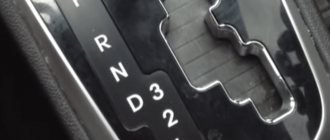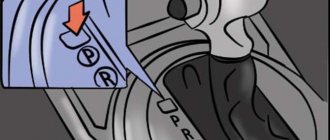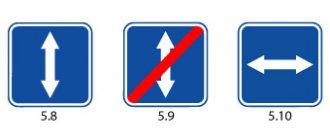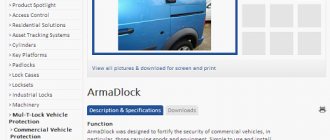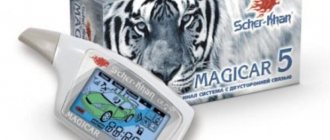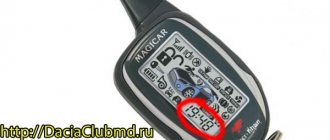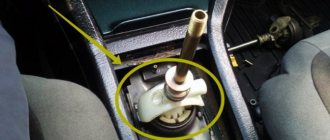Today, for a number of reasons, automatic transmission is a much more preferable option than manual transmission. This is especially true if the car is constantly used in a metropolitan area, where traffic in heavy traffic is characterized by low speeds, frequent accelerations and stops, as well as moving and idling in traffic jams.
Given this popularity, many novice drivers, as well as those who previously drove a car with a manual transmission, are actively switching to cars with an automatic transmission. Next, we will look at how to change gears on an automatic transmission, what you need to know about automatic transmission modes, and also how to engage reverse gear on an automatic transmission.
What are the automatic transmission modes? In what cases should each mode be used?
“P” – parking. In this position of the range selector lever, all controls in the box are turned off, and its output shaft is locked, making movement impossible. This mode is used when parking the car for a long time. To reduce the load on the elements of the parking mechanism on an ascent or descent, you must use the handbrake. Apply the handbrake before setting to “P”, and remove it after switching from “P” to another mode. Switching from the “parking” mode is possible only when the lock on the shift handle is released, the brake pedal is pressed, and only when the car comes to a complete stop.
“R” – reverse. The selector lever can only be moved to this position when the vehicle is stationary. Moving the lever to the “R” position while moving forward can lead to failure of the gearbox and other transmission components!
"N" - neutral. All controls in the gearbox are turned off; there is no rigid connection between the drive and driven shafts. The output shaft locking mechanism is turned off, i.e. the car can move freely. The lever should be moved to this position when the car is towed or when the car is stationary, holding it using the service brake system or parking brake, i.e. when you need to have a working car and at the same time move it freely. For example, during repairs and adjustments, measuring fluid in an automatic transmission, etc. It is not recommended to move the selector lever to the “N” position when coasting (by inertia), this does not lead to fuel savings, rather, on the contrary.
“D” is the main mode of forward movement of the car. Allows the automatic transmission to fully automatically shift gears from first to fourth/fifth. Used under normal vehicle driving conditions.
«3» – the automatic transmission shifts sequentially only to the first three gears. This position is only available in five-speed or four-speed automatic transmissions and is recommended when driving in the city, in traffic jams, with frequent braking, as well as on dirt roads and roads with constant ups and downs.
«2» – “automatic” switches only to first and second gear. You can set this position when starting to move and while driving, when the car is moving forward at a speed of no more than 50 km/h. This mode is recommended for use on dangerous dirt, forest, swampy, slippery and snowy roads where you need to move slowly. The mode has restrictions for its use when the vehicle speed is more than 80-100 km/h (depending on the type of automatic transmission). Also, you should not switch to this mode from mode “D” at a speed exceeding 80-100 km/h.
“1” or “L” – driving only in first gear. Used when starting to move and moving the car forward at a speed of no more than 25-30 km/h. This mode is required when driving off-road, snow and mud, as well as on very steep ascents or descents, mountain serpentines. also “1” / “L” , for example, to pull out a stuck car or a banal entry into the garage.
“Overdrive” – overdrive gear.
This is the button for turning on the last (direct) gear in the gearbox (3, 4 or 5). It is recommended to turn on “OD” only when the car reaches a speed of 80-100 km/h (depending on the type of automatic transmission and engine) and turn it off when the speed reaches less than 70 km/h. In this mode, the automatic transmission operates as a 3 or 4/5-speed, depending on the state of the “OD” button (which is located under the lock on the gear shift knob): if “OD-off” (i.e. the button is released) – 3 steps , if “OD-on” (i.e. the button is pressed), then accordingly 4 steps. If there is no “OD” button, then the automatic transmission is 3-speed.
Is it possible to shift the automatic transmission selector while driving?
Manual gearboxes are relatively easy to use, however, not everyone can learn to drive a car with such equipment. Cars with automatic transmission occupy a large share of the market today.
If you change from mode 3 to mode 2, engine braking will improve
Automatic transmission is easier to use, but has some features that should be taken into account during operation. For example, many motorists wonder whether it is possible to shift the automatic transmission lever while driving and whether the handbrake should be activated in parking mode?
While driving, you cannot shift the automatic transmission lever to P and R modes.
First, let's look at the first issue with gear shifting. You can use the automatic transmission selector while driving. However, not all positions can be rearranged. The main rule that a motorist should remember is that while driving, you cannot switch the automatic transmission lever to P and R modes. This can only be done when the vehicle is immobilized. Of course, you can check in practice what will happen to the gearbox, but you will not get anything other than breakdowns. In addition, some experts do not recommend switching from mode D to N. In such a situation, the connection between the wheels and the power unit is lost. If you apply sudden braking after this, there is a high probability of skidding. The selector can be moved to all other positions. In some situations this is even recommended. For example, if you change from mode 3 to mode 2, engine braking will improve. In some cases, you can shift the gear from D to 3. During an ascent, the engine power may not be enough, and the automatic transmission will begin to change gears up and down. To alleviate the situation, it is easier to move the selector to a higher gear.
Neutral is an emergency towing mode that is allowed within limited limits. Therefore, it is not advisable to use it constantly
Another interesting question regarding cars with automatic transmission is whether it is necessary to put the car in neutral when stopping? This must be done, especially in cases where the vehicle will stand in one place for a long time in hot weather. This can reduce heat generation and reduce the risk of oil overheating. Many motorists believe that at traffic lights and during a short stop they need to turn on N mode. Neutral is an emergency towing mode, which is allowed within limited limits. Therefore, it is not advisable to use it constantly. When stopping for a short time, it is better to use the brake pedal. The third question is whether it is necessary to apply the parking brake if the selector is switched to parking mode? If the platform on which the vehicle is parked is level, the output shaft locking mechanism will securely fix it. If the car is parked on a slope, then it is advisable to apply the hand brake.
Why are additional modes such as ECON, POWER and others needed?
These modes allow you to make wider use of the automatic transmission’s capabilities, depending on the situation, road surface and driver’s mood. Typically, additional modes are implemented by electronics that control the automatic transmission hydraulic system.
NORM – (ECON). The program is configured to ensure vehicle movement with minimal fuel consumption. In this case, gear shifting occurs approximately when the engine reaches medium speed. The movement of the car is calm and smooth.
PWR – (POWER, S, SPORT). The program is configured to maximize the use of engine power, so upshifts occur in the area of maximum speed, at which the engine develops maximum power. In this case, the car accelerates with high acceleration. This mode is used for a sporty driving style.
SNOW – (WINTER, W, HOLD). The program is designed to make winter driving easier: the car starts in second gear in this mode. In addition to use in winter, it is very helpful when starting to ride on hills, the surface of which consists of hard knurled soil or coarse sand and asphalt, and can also be effective when driving on wet grass and asphalt. When using in winter, you must understand that the maximum effect from the SNOW mode can only be achieved if it is combined with good winter tires.
How to change gears on an automatic transmission
The mode change occurs after appropriate actions by the driver - changing the position of the selector, pressing the pedals, etc. Gear shifting occurs automatically according to the selected driving function and depending on the engine speed.
Correct hand position when changing speed.
However, many car models with an automatic transmission are also equipped with a manual shift method. It can be designated as Tiptronic, Easytronic, Steptronic, etc.
When this function is enabled, the driver can independently select the optimal gear using the “+” and “-” buttons on the lever or the gradation on the dashboard.
This function is useful in cases where the driver’s reaction and experience are more effective than the automatic transmission algorithms: for example, when trying to start a slipping car, driving down a slope, driving on an uneven road, etc.
The mode is semi-automatic, so when high speeds are reached, the automatic transmission can change gear despite the driver's actions.
How to correctly use the automatic transmission modes of an SUV?
On SUVs equipped with an automatic transmission, the main automatic transmission modes are exactly the same as on passenger cars, but with range (transfer case) modes they significantly increase the vehicle's capabilities. For example, a very common type of Part Time transmission (all-wheel drive) has four main range modes: “2H” (rear-wheel drive), “4H” (all-wheel drive without locking), “4HL” (all-wheel drive with center differential lock) and “4НLL” (all-wheel drive with low gear and center differential lock). All of these modes can be used with any automatic transmission mode, and the choice depends on the driving situation.
For example, for driving on asphalt and dirt roads without load, it is better to use the “D-2H” mode. When driving on mud, wet grass, ice and shallow snow (without load), the “D-4H” mode is quite sufficient. To overcome ascents, descents (slippery, loose), various irregularities (rocks, holes), etc. you can use the “D-4HL” or “2D-4HL” mode depending on the speed and road surface. When driving off-road (deep mud, snow, fords, dangerous climbs and descents), it is better to use the full potential of the transmission - turn on “2D-4HLL” or “L-4HLL” depending on the conditions. The main thing is to remember that in most cases, the range modes are activated only in the “N” position of the automatic transmission selector, i.e. at a complete stop and in advance (with the exception of the Super Select transmission installed on some Mitsubishi models).
What is kickdown?
Kickdown is an automatic transmission mode in which a forced shift down one or two gears (depending on the speed) occurs when the gas pedal is sharply pressed. This mode is recommended for faster acceleration, such as when overtaking or when sudden acceleration is required. Reverse upshifting in this mode occurs only when the engine reaches maximum speed. If you release the gas pedal, the gearbox will return to normal operation.
It should be borne in mind that on a slippery road, during a forced downshift, the drive wheels may begin to slip, and this can lead to a skid.
Is it possible to change the range selector while driving?
Only in some positions! It is strictly forbidden, for example, to move the selector lever to the “P” and “R” positions when moving forward. The lever can only be moved to both of these positions when the vehicle is completely stopped. Violation of this rule can lead to serious damage to the automatic transmission. In addition, it is not recommended to move the lever to the “N” position while driving, since in this case the connection between the wheels and the engine is lost and sudden braking can cause the car to skid. The lever can be moved to all other positions while moving. In some cases, it is even recommended to do this on purpose. Thus, moving from position “3” to position “2” increases the efficiency of engine braking, etc.
Additional automatic transmission operating modes
On modern versions of cars, the automatic transmission has a large number of additional operating modes (switch buttons). Let's look at their features:
An automatic transmission may have an “OD” (Overdrive) button. It is necessary to engage an upshift. For diesel versions of cars, this transmission can be activated at any time.
Thus, additional modes of the automatic transmission allow you to use its capabilities more widely. It is not recommended to travel off-road in a car equipped with an automatic transmission. The automatic machine does not like wheel slipping.
Source
Is it possible to tow a faulty car with an automatic transmission?
It is possible, but it is necessary to set the automatic transmission selector to the “N” position and tow the car, strictly observing the following rules: - cars with a 3-speed automatic transmission can be towed, not exceeding a speed of 40 km/h, for a distance of up to 25 km; - cars with a 4-speed automatic transmission - not exceeding a speed of 50 km/h, for a distance of up to 50 km. There is also a recommendation (only in the case of an idle engine) to fill the automatic transmission with the maximum possible amount of fluid for the automatic transmission before starting towing (and then do not forget to drain the excess!). But it’s better to call a tow truck.
Prepared by Pavel DRUZIN based on materials from the automotive press.
up
What happens if you change gear without a clutch?
Naturally, there is no need to practice this all the time without doing anything. And you are unlikely to be able to do this intentionally and easily. A difficult task. Because the driver will encounter such serious vibration on the lever that it will immediately become clear that it’s time to end such experiments.
Still, let's not forget that gears and rims are products made of alloy steel. A person does not have much strength to “defeat” them. There is definitely a small chance that the teeth will be able to match, resulting in a gear change. But the chances of this are very small. The most important thing here is the moment of engagement of the lever with the gear. But he doesn’t exist, as you understand.

